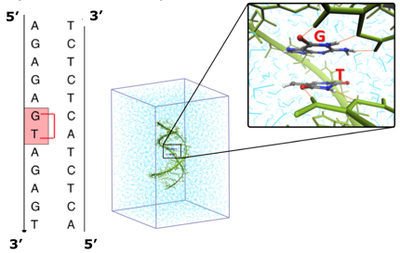Chandan Patel
Complex DNA lesions : Insights from QM/MM—MD.
Chandan Patel
DNA is continously exposed to a vast number of damaging events triggered by endogeneous and exogeneous agents.[1] Formation and structure variety of these lesions have been studied using experiments. Although experimental studies, within their confines, have provided very useful information regarding structural properties of some of the DNA lesions and their repair, they do not provide any mechanistic or energetic information pertaining to their formation.
Computational Biochemistry has recently beneficiated from the advent of a large scale methods [2], which rely on the increase of available, highly-parallelized computational resources, but were first and foremost motivated by the utter need to describe as accurately as possible complex, strongly heterogeneous systems. Such multiscale and dynamical simulations have become routine for proteic systems [3], yet remain scarce on DNA. In the first seminal example in 2004, Parrinello and coworkers stressed out the importance of the B-helix environment on guanine radical cation structure. [4] QM/MM methodologies are particularly useful in this regard, as they can be used to study reaction mechanisms and electronic porperties in large systems. Presently, we study oxidatively generated intrastrand crosslinks within DNA. [6] In absence of NMR or X-ray structures, the B-helix distortion can be inspected purely on the basis of molecular simulations. Preliminary results obtained on other oxidative cross-link adducts, such as dCyd341, will also be discussed. [7]

[1] T. Lindahl and D. E. Barnes. Repair of endogenous DNA damage. Cold Spring Harb Symp. Quant. Biol., 65: 127-134, 2000.
[2] E. H. Lee, J. Hsin, M. Sotomayor, G. Comellas, and K. Schulten. Discovery Through the Computational Microscope. Structure, 17:1295-1306, 2009.
[3] J. A. McCammon, B. R. Gelin, M. Karplus. Dynamics of folded proteins. Nature, 267:585, 1977.
[4] F. L. Gervasio, A. Laio, M. Iannuzzi, and M. Parrinello. Influence of DNA Structure on the Reactivity of the Guanine Radical Cation. Chemistry A European Journal, 10:4846-4852, 2004.
[5] J. Garrec, C. Patel, U. Rothlisberger, and E. Dumont. Insights into Intrastrand Cross-Link Lesions of DNA from QM/MM Molecular Dynamics Simulations. Journal of the American Chemical Society, 134:2111-2119, 2012.
[6] C. Patel, J. Garrec, C. Dupont, and E. Dumont. What Singles Out the G[8-5]C Intrastrand DNA Cross-Link? Mechanistic and Structural Insights from Quantum Mechanics/Molecular Mechanics Simulations. Biochemistry, 52:425-431, 2013.
[7] P. Regulus, B. Duroux, P. A. Bayle, A. Favier, J. Cadet, and J. L. Ravanat. Oxidation of the sugar moiety of DNA by ionizing radiation or bleomycin could induce the formation of a cluster DNA lesion. Proceedings of the National Academy of Sciences, 104:14032, 2007.



